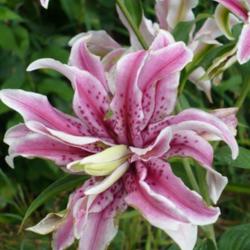
The first thing you need to do is select the types of lilies that you would like to grow. Some factors in choosing the right lily for your garden may include ease of growing, flowering time, color, and height.
 |
 |
 |
 |
Next, you want to think about where you would like to purchase your lilies. Lilies can be acquired from a variety of sources. Companies that provide good customer support and stand behind their bulbs are my favorite places to purchase lily bulbs. The bulbs will arrive at the proper planting time for your area and will be guaranteed true to name. In other words, these are companies that will provide you with a replacement or credit in case of error. Garden-tested lily varieties make the best garden lilies. There are companies that specialize in lily bulbs. Our Recommendations feature can help you find the companies that our ATP members like to purchase from.
 |
 |
Site selection is important to consider. Lilies enjoy excellent drainage and good air circulation. If air circulation is an issue, problems like Botrytis ( a fungal disease) can result in the decline of your lilies. Six hours of sun per day minimum is required for optimal growth. Planting in too much shade can result in very tall, leaning lilies with lower bud counts and eventual decline.
 |
 |
Lilies make excellent cut flowers. If you choose to cut a lily stem, never take more than 1/3 of the stem. The energy for future growth comes from the leaves and will be stored in your bulb. Another tip is to remove potential seed pods. This will ensure that the energy is not spent developing seed pods.
 |
 |
You have selected an adequate site now. When planting your lily bulb, you will want to plant it at least twice the depth of the bulb. It is better to plant deeper than to plant too shallow. If your soil is heavy, you will want to add adequate compost to your soil. Adding compost will enrich the existing soil and ensure proper drainage. After planting, you will want to thoroughly water your bulb into the ground, even if you are planting in the rain. A thorough watering will allow roots to come into direct contact with the soil and will give your lilies a great start.
 |
 |
 |
 |
 |
Lilies may also be planted in containers. Pots at least 18 inches deep are ideal. Bulbs need to be planted with enough depth for stem root development. Holes in the base of the pot are necessary for adequate drainage. Do not overwater. Also placing some lower growing annuals will help keep the lily roots cool in a pot or in the garden. Lilies enjoy cool roots and sunny faces.
 |
 |
After a few years, you may notice your bulbs multiplying. What started as one bulb may now be several bulbs. If you notice your bulbs crowding, lifting and separating them in the late fall for replanting may be helpful. It is a gift. You can share these "extra" bulbs or replant in another adequate location. Overcrowding can contribute to botrytis problems and bulb decline. Adding a topdressing of compost to existing lily plantings in fall can help to enrich the surrounding soil for lilies that do not need transplanting.

Cut lily stalks down in late fall and discard them. Leaving a small portion of the stem above ground can help you know where to expect growth to emerge the next spring. Composting is not recommended due to disease potential.
Lilies are easy to grow and can be enjoyed for many years when given basic care. Enjoy each bloom the season gives you.
  |
 |
| Thread Title | Last Reply | Replies |
|---|---|---|
| Any suggestions to prevent moles or voles from eating the bulbs? by BookerC1 | Sep 18, 2016 7:17 PM | 4 |
| Untitled by Nhra_20 | May 1, 2016 7:48 PM | 0 |
| Lily tutorial - perhaps a comment on soil acidity might be added by Cantillon | Jul 22, 2013 4:36 PM | 2 |
| Great article by ge1836 | Jul 21, 2013 12:15 PM | 6 |
| small red insects ... lily leaf beetle...can destroy your lilies by tomtomtomtom | Jul 20, 2013 5:57 AM | 1 |